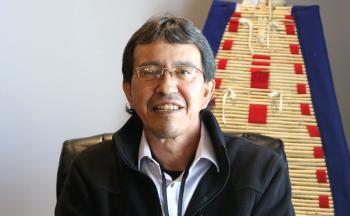Image Caption
Summary
Local Journalism Initiative Reporter
Windspeaker.com
Funding announced last week by the province to advance continuing care capacity both on and off reserve and Métis settlements is welcomed, but only a drop in the bucket of what is needed.
Continuing care, defined by Alberta Health Services (AHS), is home care, supportive living, long term care, hospice and end-of-life care. Alberta Health has allocated approximately $154 million over three years in a new Continuing Care Capital Program.
The funding covers three streams, the first of which “focuses on developing continuing care capacity with Indigenous groups and organizations,” according to the news release.
“Indigenous people in our province need access to local care equipped with culturally-relevant services,” said Health Minister Tyler Shandro in a statement. “This new program will offer an opportunity to develop continuing care spaces sensitive to the needs of Indigenous communities through capital grant funding.”
The program has three streams of funding from the same pot, two of which are open to non-Indigenous projects as well.
“In no way do we want to be offensive in terms of the appreciation for that (funding), but really, that’s … a kick at the can,” said Derrick Fox, CEO of the Blood Tribe Department of Health Inc. “We’ll stretch out whatever we’re able to be approved for… but we don’t see it as being as significant as needed.”
The Blood Tribe operates one of less than a handful of continuing care facilities located on-reserve.
Fox says no one can deny there’s value to keeping Elders in the community.
“It is so important. It is our connection to our spirituality, to our ancestors in that sense that they are our historians, our knowledge keepers, passing that information on,” he said.
But funding continuing care facilities on-reserve falls into a grey area. The federal government won’t fund long term care because it says that level of care is a provincial responsibility. However, reserves fall under federal jurisdiction.
Since fall 1999, when the 25-bed Kainai Continuing Care Centre started operating, the $2.2 million to $2.5 million annual operating budget has largely been covered by the Blood Tribe’s own-source revenue. A few years ago, an agreement was reached with AHS to provide funding for some of the health programs offered at the care centre.
The facility is 22 years old, with systems that need to be replaced, a roof that needs to be repaired and maintenance that can go beyond simple upkeep, says Fox.
“The building (is) aging every day so those needs are staring at us. So it would be huge, any funds that we can receive, to support the upkeep of that,” he said.
The new program, which offers one-time capital grants to support building, upgrading or renovating continuing care spaces, could have made a difference last October and November when three residents in the continuing care facility tested positive for the coronavirus. One Elder passed away.
“If we had a little bit more to work with maybe we could have had further modifications,” said Fox, adding, “COVID has exposed some of the challenges needed in long term care.”
It took about a month to get the outbreak under control and Fox says support was received from both AHS and the First Nations Inuit Health Branch of Indigenous Services Canada.
“It was an anxious time for myself personally. Anytime we have losses it’s very hard. Just the anxiety of not knowing what the impact was going to be. If they were all going to get (coronavirus), if they were all going to survive,” he said.
That anxiety is returning as a fourth wave of COVID-19 hits the country.
Fox says they will be pro-active, which includes getting facility residents a third vaccine or booster shot if that is recommended by the National Advisory Committee on Immunization. Limiting visitors and encouraging family members to get vaccinated are also among the steps that will be taken.
“It is weighing with the visitation but also to the safety,” said Fox, who points out that Elders get lonely and suffer from mental health fatigue when cut off.
According to the news release, the Continuing Care Capital Program helps to address one of the recommendations from a report on improving the quality of life for continuing care residents, which was prepared for Alberta Health and delivered this past April. That recommendation calls tor increasing the level of collaboration with Indigenous leadership and organizations to provide more culturally appropriate continuing care services closer to home.
That report also called for the immediate creation of a "dedicated team from Alberta Health/AHS to work collaboratively with Indigenous leaders/organizations ... to establish a process for developing and funding continuing care services in Indigenous communities."
“Part of this work is already underway … (and) additional work will be identified through the action planning process,” said Alberta Health spokesperson Chris Bourdeau in an email response to Windspeaker.com.
Fox said his department was “not necessarily directly” involved in providing input for that report.
“For a lot of us that have long term care beds, the message is very similar: the supports are lacking in this area. We could have said long ago that there are long term beds on the outside (but) that is not our mandate. (There is) that understanding that our people need one another,” said Fox.
More operational dollars are also needed, he said.
Deadline for applications from Indigenous groups and organizations for the first stream of grant funding for capital costs is Dec. 17.
Local Journalism Initiative Reporters are supported by a financial contribution made by the Government of Canada.

